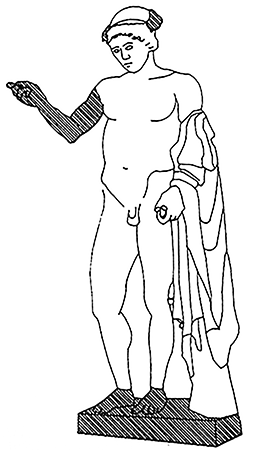
Roman copy late 1st — early 2nd cent. CE after a Greek original of the 5th cent. BCE. Inv. No. 8624.Rome, Roman National Museum, Palazzo AltempsPhoto by Sergey Sosnovskiy
Hermes Ludovisi (Mercury the Oratore).
Roman copy late 1st — early 2nd cent. CE after a Greek original of the 5th cent. BCE.
Rome, Roman National Museum, Palazzo Altemps
(Roma, Museo nazionale romano, Palazzo Altemps).

Hermes (Mercury) Logios Ludovisi Collection.
Medium-grained (Pentelic) marble.Inv. no. 8624.
The gesture of the figure of Hermes (Mercury) has caused the descriptive Logios to be added, to signify the god of eloquence, characterized by the oratorical gesture of the raised right arm: this sculpted image is however due to a restoration by Algardi, which aimed at giving the iconography of the god a different aspect from that originally intended.
The statue is a copy from the Roman era (end of the first century-beginning of the second century A.D.) of a Greek bronze statue from the fifth century B.C., perhaps the work of Phidias, the sculptor of the Parthenon, or of an artist of his school. The concentrated and sad expression of the face recalls a funerary sculpture, with the right arm slightly raised in a gesture of farewell; the left hand held the caduceus, a branch with two intertwined serpents, which is the typical attribute of the god, represented as a Psychopomp, who accompanies the souls of the dead into the underworld. In 1631 Alessandro Algardi restores the sculpture, refashioning the right arm, the feet with the base, the tip of the nose and also the attributes typical of this divinity, such as the edge and wings of the petaso, the hat with the wide brim, the little bag in the left hand and the caduceus in the right; these additions, now removed, are reproduced in Claude Randon’s drawings, printed in 1704.
The antique decoration of statues frequently involved their being painted, especially the head and the clothing: this one must have been painted and gilded in the hair, where the red tint that remains indicated the preparation for gilding.